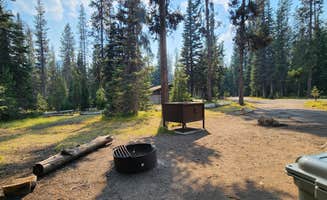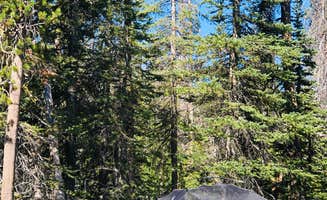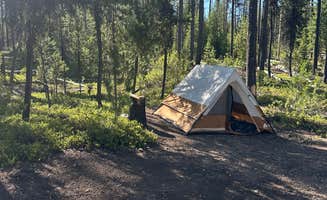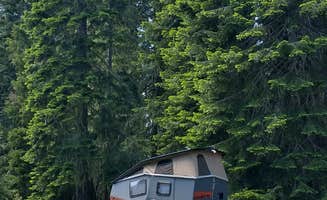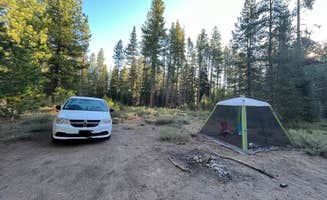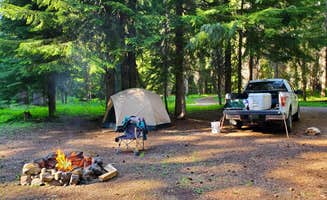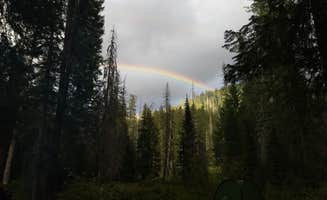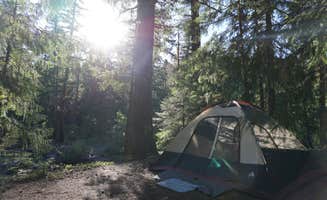Crater Lake National Park sits at an elevation of 6,178 feet, making camping in this area much cooler than surrounding regions with overnight temperatures sometimes dropping into the 30s even in summer months. The volcanic landscape around Crater Lake creates distinct camping environments with pumice soil that drains quickly after rain. Dispersed camping options outside the park boundaries offer alternatives when the park's primary campground reaches capacity during peak season.
What to do
Hiking trails access: At Annie Creek Sno-Park, campers can easily reach several trails. "There are a few primitive spots down the small road near the entrance of the lot. I stayed on the one near the creek it's quite nice and about 40 min from crater lake," notes Zyle Y.
Fishing opportunities: Diamond Lake provides excellent fishing access just north of Crater Lake. "Such a beautiful campground! This campground has beautiful lake views, access to bathrooms and showers, and ice cream and firewood just a walk or bike ride away!" shares Macy G.
Photography spots: The Mount Thielsen Wilderness area offers unique vantage points for photography. "We found a sweet spot in the rubble. Quiet, great view and amazing sun. Beautiful cotton candy sunset waking to a beautiful bright sunrise," reports Paula who camped in the area.
Stargazing sessions: Clear mountain air at higher elevations creates prime night sky viewing conditions. A camper at Broken Arrow Campground noted, "Loved that there was minimal lighting at night and just yellow bulbs to reduce attraction to bugs. Made for wonderful day night sky viewing."
What campers like
Private creek access: Many camping spots near Crater Lake, Oregon feature waterfront sites. At Union Creek Campground, "My site felt really private since we couldn't see any other campers through the dense forest... Sitting out by the creek while the sun was coming up in the morning was a definite highlight," shares Madelyn H.
Wildlife encounters: The forests around camping areas host diverse wildlife. At Broken Arrow Campground, one camper mentioned, "Chipmunks everywhere :)" while others report seeing rabbits and various bird species throughout the area.
Temperature variety: The region offers temperature flexibility based on elevation. At Jackson F. Kimball State Park, located at lower elevation, Steven noted: "Clean and simple campground... Beautiful little lake/Creek next to the campground," though he warns about "an abundance of mosquitos, like so so many."
Free camping options: For budget-conscious campers, several free dispersed sites exist. At NF-70 Dispersed Camping, "Huge site, perfectly level, in the woods. Not many mosquitoes. Solid T-mobile coverage," reports Kurt Z.
What you should know
Seasonal limitations: Most campgrounds operate between late spring and early fall due to heavy snowfall. "We went in late October and it got down to 14 degrees at night. It was not snowing. But, do pack snow gear for that weather and have hot coffee for the morning," advises James W. who camped in Mount Thielsen Wilderness.
Insect protection needed: Multiple campers mention mosquitoes as a significant concern. At Diamond Lake, Candice B. warns: "Be prepared to fend off mosquitoes if you're going in the summer! The showers and bathrooms were clean and well maintained."
Cell service limitations: Connectivity varies widely across the area. At Thousand Springs Sno-Park, one camper observed, "Zero cell service anywhere in this entire area. Crater Lake visitor center had good wifi for free though."
Toilet facilities: Most established campgrounds offer basic facilities. One camper at Annie Creek Sno-Park mentioned, "Pit toilets available but no other facilities. Very dusty, bumpy road. Not many sites available however it was very peaceful."
Tips for camping with families
Child-friendly spots: Choose campgrounds with appropriate facilities for children. At Mazama Village Campground, Katy T. notes: "I gave this campground 3 stars because it is not for adventurers, it is a campground for families. There is a lot to offer for families though, clean bathrooms, restaurants, paved pathways, easy access to the lake."
Space considerations: Some campgrounds offer more room for children to play. At Diamond Lake, Kyahn D. observed: "Huge campsite but it doesn't feel that way when you are at your site. The sites by the lake appeared to be much larger than the ones further up the hill."
Activity planning: Plan for varied weather conditions when bringing kids. Michael L. at Diamond Lake shared: "We stayed at this campground over Memorial Day weekend in a C loop single site, and there was no disappointment! The mosquitos were fairly tame, the water was pure and clean, other campers kept quiet and to themselves."
Wildlife education: Use camping as an opportunity for wildlife lessons. At Broken Arrow Campground, many families report teaching children about local wildlife like chipmunks while maintaining safe distances.
Tips from RVers
Size restrictions: Choose campgrounds that accommodate your vehicle. Laura M. at Thousand Springs Sno-Park reported: "There is a huge lot that would fit many RVs, easy turnaround and plenty of room to spread out. It is right on 62 so you'll hear cars go by but traffic was really light in May."
Road conditions: Access roads vary in quality across the region. Ray & Terri F. at NF-70 Dispersed Camping noted: "NF-70 is gravel and in pretty good shape, i.e., no potholes, but is heavily washboarded. This wasn't an issue for the Cherokee, but with a stiffer suspension, I had to limit the RV speed to less than 7 mph to keep from shaking it apart."
Dump station access: Plan for waste disposal needs when camping with an RV. At Diamond Lake, Marcus K. appreciated that "The free showers and dump station was a plus" when staying near Crater Lake.
Generator policies: Check rules regarding generator use at each location as policies vary across camping areas around Crater Lake, with many forest service sites limiting hours or prohibiting use entirely.


